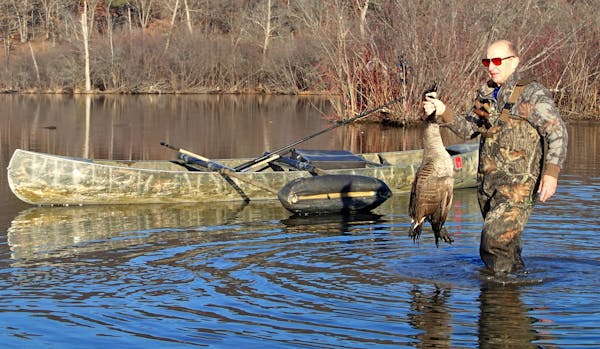Tom Landwehr, a waterfowl biologist who was hired by the state Department of Natural Resources in 1982, is entering his sixth year as the agency's top gun. He sat for an exclusive interview this week, where he was proud of prairie restoration, regretful of his own late arrival to walleye and deer management issues, worried about groundwater pollution and determined to build a DNR office on the shores of Lake Mille Lacs. Here's a condensed version of what he said:
Q What's been your signature achievement so far?
A One of the things that I'm proud of right now is restoring grassland prairie as well as introducing a pheasant plan. The loss of grassland is the primary conservation issue facing our state. We've been able to combine a lot of different programs to protect what limited native prairie we have …. After a really long time it feels like it's pulling together. Roughly 60 percent of the most recent funding recommendations by the Lessard Sams Outdoor Heritage Council are supportive of prairie restoration and our pheasant plan. … But we're still way short of the more than 2.5 million acres of conservation land needed to preserve major components of our native prairie.
Q Other accomplishments?
A We've done good work around aquatic invasive species. … Counties are now involved with new funding and we're giving them direction. We're also close to the University of Minnesota Invasive Species Center, helping us figure out long-term issues. It feels like now we have the right things in place. It is slowing things down. Is it good news, bad news? Yes. Every year we have another species. A number of lakeshore property owners want us to close public accesses. We are not backing down on public access.
I'm also proud of our forest program. Besides producing wood for industry, we are working with economic development agencies to ensure we have healthy companies to buy timber.
Q Regrets or disappointments as commissioner?
A In regard to declines in the deer herd and Mille Lacs walleye population, in both cases I regret that I didn't jump in and engage more fully, earlier. I'm not certain it would have changed the outcome, but at least I would have been more fully engaged. With deer, we had been trying to downsize the herd and that didn't sound like a bad thing. Then we got dinged with two bad winters. I wish I would have spent more time getting more background information about our goal-setting.
Q We hear you are planning to build a fisheries office on Mille Lacs.
A We will get a building on that lake. That's my goal. We own land on Mille Lacs. We haven't settled on a location yet, but we are looking to see if our site near Garrison is buildable. The cost estimate is $3.5 million. It's very exciting. … I just think Mille Lacs is kind of a poster child for needing an office on it.
Q The top deer-management job at DNR is vacant. Will you be involved in making that hire?
A Obviously, deer hunting is extraordinarily important in Minnesota, so we want the right person. The search is nationwide, but that doesn't exclude internal candidates. When I was a biologist here, down on the second floor, I learned from the late Roger Holmes [former fish and wildlife chief] that the single most important thing is hiring good people. If you get the right person in the job, you blow it out of the water.
Q Other states have copied your leadership in making state parks free for admission on Black Friday. How did you come up with the idea?
A I saw the REI decision [to close on Black Friday] and thought that was pretty courageous. It's such a consumer-driven day. Why not create the notion that you don't just have to go shopping? We have the assets to get people outside. We bounced it around, including with the governor, and said, 'Let's go with this.' It was serendipitous and multiple states jumped on the bandwagon.
Q What will you be asking of the Legislature in 2016?
A We need bonding money to address deferred maintenance to our 2,700 facilities around the state. … When I took this job, the DNR had no detailed infrastructure replacement plan. I was surprised by that. Now we have an inventory assessment and a 10-year plan.
Q Is the DNR doing enough to protect groundwater from farm pollution?
A Impairment of surface water and groundwater in the southwest region of our state is a huge problem. … We know there is widespread nitrate contamination and there are probably other impairments that we are not yet measuring. Now we will be taking degradation into consideration when issuing permits for groundwater usage, especially up by Park Rapids, where forest has been converted to potato fields.
Q Given your job demands, do you still get out hunting?
A I consider it a health requirement, so, yes. But not as much as I'd like to. I'm getting out for pheasant — that's been my salvation this fall — and I made the deer opener with my son, Hunter. But my big duck hunting trip [north of Winnipeg] with my buddies got blown up. I had to work.
Tony Kennedy • 612-673-4213

Wolves vs. Suns: Here are the match-ups . . . and a series prediction
Rockies' Kyle Freeland out up to 6 weeks with elbow injury. He says pitch clock may have been factor
Former Twins top draft pick Dave McCarty dead at 54
![Minnesota Twins pitcher Jhoan Duran (59) in the ninth inning Tuesday, August 15, 2023, Target Field in Minneapolis, Minn. ] CARLOS GONZALEZ • carlos](https://arc.stimg.co/startribunemedia/NWLT5CNXGTRZA6KVTMIPSOG3KI.jpg?h=91&w=145&fit=crop&bg=999&crop=faces)
Twins closer Duran could begin rehab assignment next week

